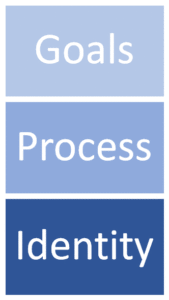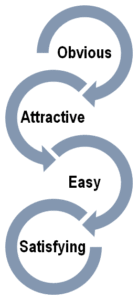I just finished a series of posts on nutrition and am once again reminded of the difficulty of sustaining good eating habits. Having just read James Clear’s Atomic Habits, it seemed an auspicious time to revisit the topic of behavioral change.
James’ core thesis is that seemingly small and unimportant daily adjustments become the compound interest of self-improvement. Think about it. When we commit to being 1% better at any activity every single day, we’ll be 37.8% better at it by year end. Conversely, when we diminish competency at a rate of 1% per day, we’ll have 2.5% of that skill one year later. He says: “Time magnifies the margin between success and failure. It will multiply whatever you feed it.”
 James defines three layers of behavioral change. Goals/outcomes provide a high-level description of a future state; they set the direction. Processes establish the systems and daily routines that produce favorable results; they chart and stay the course. A declared identity tells us who we wish to become. Why does identity matter? Because outcome-based habits that focus on achievement can be thwarted by an old, engrained identity. By contrast, identity-based habits motivate us to act according to who we believe ourselves to be. As such, when we’re tempted to forego the daily regimen, we can ask ourselves: Does this behavior (or lack thereof) cast a vote in favor of the person I’ve declared myself to be?
James defines three layers of behavioral change. Goals/outcomes provide a high-level description of a future state; they set the direction. Processes establish the systems and daily routines that produce favorable results; they chart and stay the course. A declared identity tells us who we wish to become. Why does identity matter? Because outcome-based habits that focus on achievement can be thwarted by an old, engrained identity. By contrast, identity-based habits motivate us to act according to who we believe ourselves to be. As such, when we’re tempted to forego the daily regimen, we can ask ourselves: Does this behavior (or lack thereof) cast a vote in favor of the person I’ve declared myself to be?
As covered in an earlier post, habits take the form of a cue, a craving, a routine, and a reward. Once formed, our brain activity drops precipitously between the cue and the reward. In a sense, we go on autopilot. It takes conscious effort to create good habits and break bad ones. We can make things easier on ourselves by shaping our environments such that we do not have to exercise extraordinary self-control or needlessly deplete our reservoir of willpower. James recommends the following high-level strategies:
| To Form a Good Habit | To Thwart a Bad Habit | |
| CUE | Make it obvious | Make it invisible |
| CRAVING | Make it attractive | Make it unattractive |
| ROUTINE | Make it easy | Make it difficult |
| REWARD | Make it satisfying | Make it unsatisfying |
The balance of his book provides concrete advice on how to enact each of these strategies along with engaging stories from those who model forwarding behavior. Here’s a high-level synopsis:
Make it obvious:
- Log your daily habits and rate them positive, negative, or neutral. Awareness is a precursor to change.
- Set an intention and stick with it – e.g., whenever I am tempted to eat between meals, I will grab celery and carrots.
- Add a new good habit on top of something you already do – e.g., whenever I go to the bathroom, I will follow up with 20 abdominal crunches.
- Create an environmental cue that reinforces the desired behavior – e.g., put my guitar on a stand in my office to remind me to play. James says: “Environment is the invisible hand that shapes human behavior… You can’t stick to positive habits in a negative environment.”
Make it attractive:
- Tie a habit that you need to do with something that you want to do – e.g., while exercising on my portable Stairmaster, I’ll take a mid-afternoon work break to watch my favorite show.
- Associate with people who model habits you want to emulate. Proximity and social norms powerfully influence behavior. Shared identity bolsters personal identity.
- Increase motivation by reframing actions as things you “get to do” rather than things you “have to do.” Tie that sense of agency with a thought, feeling, or action that brings joy right before launching the routine.
Make it easy:
- Remove barriers. Have all the necessary materials at the ready to engage in positive change.
- Make good environmental decisions – e.g., join a gym that’s on the flight path to work, grocery store, or other frequent haunts.
- Pay attention to the moment of choice every day and learn to master it – e.g., set the calendar to include self-care activities and treat these time slots as non-negotiable.
- Create 2-minute routines – e.g., meditate for 2 minutes every day upon awakening. Extend the time in 1 increments when it feels natural to do so.
- Leverage technology to automate habits – e.g., deduct X amount from the weekly paycheck and put it in a savings plan
Make it satisfying:
- Find ways to give yourself immediate rewards for behaviors that provide long-term benefits. Choose rewards that strengthen identify and goals. (A brownie after a workout does not fit the bill!)
- Reinforce good choices visually – e.g., place money saved on impulse purchases in a glass jar and watch it accumulate.
- Place a habit-tracker in a prominent location to encourage yourself to stay the course and celebrate daily progress.
- Commit to “getting back on the horse” if you break the chain. Be a person who does not falter twice in a row.
I really enjoyed this book and recommend that you grab a copy and read it. You’ll get far more benefit out of his words of wisdom with in-depth exposure. If it changes your life for the better, isn’t it worth the investment?
